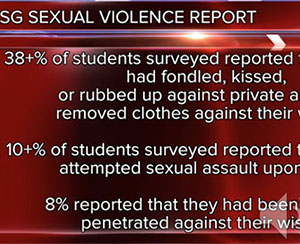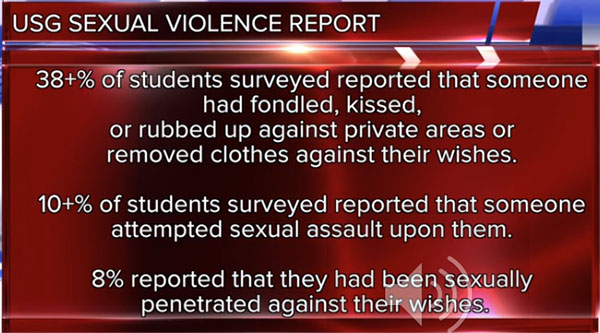
Perhaps this is more about survey phrasing, but it’s telling: Ohio State University has unusually low sexual-assault rates, at least compared to the popular but problematic 1-in-5 statistic.
The Lantern‘s “Scarlet Scoop” program says that a student government survey of more than 600 undergrads found that about 10 percent reported “someone trying to have intercourse against their will,” while 8 percent said “that actually happened.”
A plurality of students – 2 in 5 – said they were the victims of fondling, kissing, or rubbing against “private areas” or that someone tried to take off their clothes against their wishes.
It’s unclear whether the attempted and completed sexual-assault answers overlap at all, or whether the reported assault attempts were not completed, in which case the completed or attempted assaults would be 18 percent – closer to the 1-in-5 ur-stat.
The student government’s survey, which was apparently released three weeks ago but not reported until Thursday, doesn’t clarify.
Students themselves showed the ambiguity that’s often involved with sexual activity in their survey answers:
About 1-2% of students selected “unsure” to one or more of the options. One student explained: “I never said out loud that I didn’t want to but didn’t actually want to so I don’t think that it counts but I’m not sure.” Another student explained uncertainty with, “I don’t know what constitutes permission.” Many explained that they had been drugged or were too intoxicated to remember what happened, but are still unsure as to whether consent was given. Similarly, 75% of those who reported victimization to a form of sexual violence reported that their perpetrator did the act by catching them off guard, or ignoring non-verbal cues or facial expressions, and 56% said that their perpetrator took advantage of them when they were too drunk, high, asleep, or in a poor state of consciousness. 88% of these acts of sexual violence were completed or attempted by a male and 11% of these acts of sexual violence were completed or attempted by a female.
Those responses pointing to “non-verbal cues or facial expressions” as evidence against consent are particularly interesting, because the “yes means yes” standard for consent that so many schools are considering doesn’t necessarily mandate verbal consent.
Though the student government recommends the school adopt the yes-means-yes standard, it doesn’t clarify whether consent should be required verbally or whether cues are OK (page 16):
We believe that Ohio State should eliminate any doubt about presence of consent by codifying a “yes means yes”, explicit and ongoing consent policy, within our Student Code of Conduct. A lack of a verbal/physical “no” should not and does not equate to a mutual agreement to proceed with sexual activity—students don’t always understand this, but we can help them to. In the recent Code Review (2012) language was adjusted to be clearer about consent, but an Affirmative Consent policy would further remove ambiguity.
This isn’t the first time OSU’s stats have been called much lower than the 1-in-5 ur-stat: Using the White House’s own estimates for underreporting, one professor said the school’s rate was closer to 3.1 percent completed rape as of its 2014 year-end report.
Greg Piper is an assistant editor at The College Fix. (@GregPiper)
Like The College Fix on Facebook / Follow us on Twitter
IMAGE: The Lantern screenshot
Like The College Fix on Facebook / Follow us on Twitter







Please join the conversation about our stories on Facebook, Twitter, Instagram, Reddit, MeWe, Rumble, Gab, Minds and Gettr.